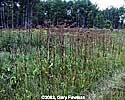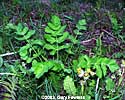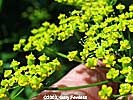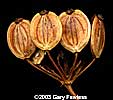
Invasive Plants of Wisconsin
| Pastinaca
sativa L. wild parsnip Family: Apiaceae |
||||||||||||||||
|
||||||||||||||||
|
Wild parsnip is an herbaceous plant requiring 2 or more years to flower and then dying (monocarpic). It grows to about 3 feet or a bit more and can form dense stands as shown above. It is successful on a variety of soils and from moist to dry conditions. In northern Wisconsin it is most commonly found along roadsides and in abandoned fields and pastures. The compound umbels of small yellow flowers appear in June and by the end of August seeds are nearly mature. Contact with the plants can cause a severe dermatitis (staining of the skin, strong rash and even open sores that take a long time to heal), especially if the affected skin is also exposed to sunlight. People attempting to control this species are advised to wear gloves, long sleeves, long pants etc. to avoid direct contact. Control methods have not been clearly described over a wide range of conditions, but digging up plants in small populations is effective and repeated cutting of the root crown (cutting below the soil surface with a shovel) in successive years appears to be effective also. The effects of fire or mowing appear to be unpredictable and may encourage wild parsnip.
|
|







